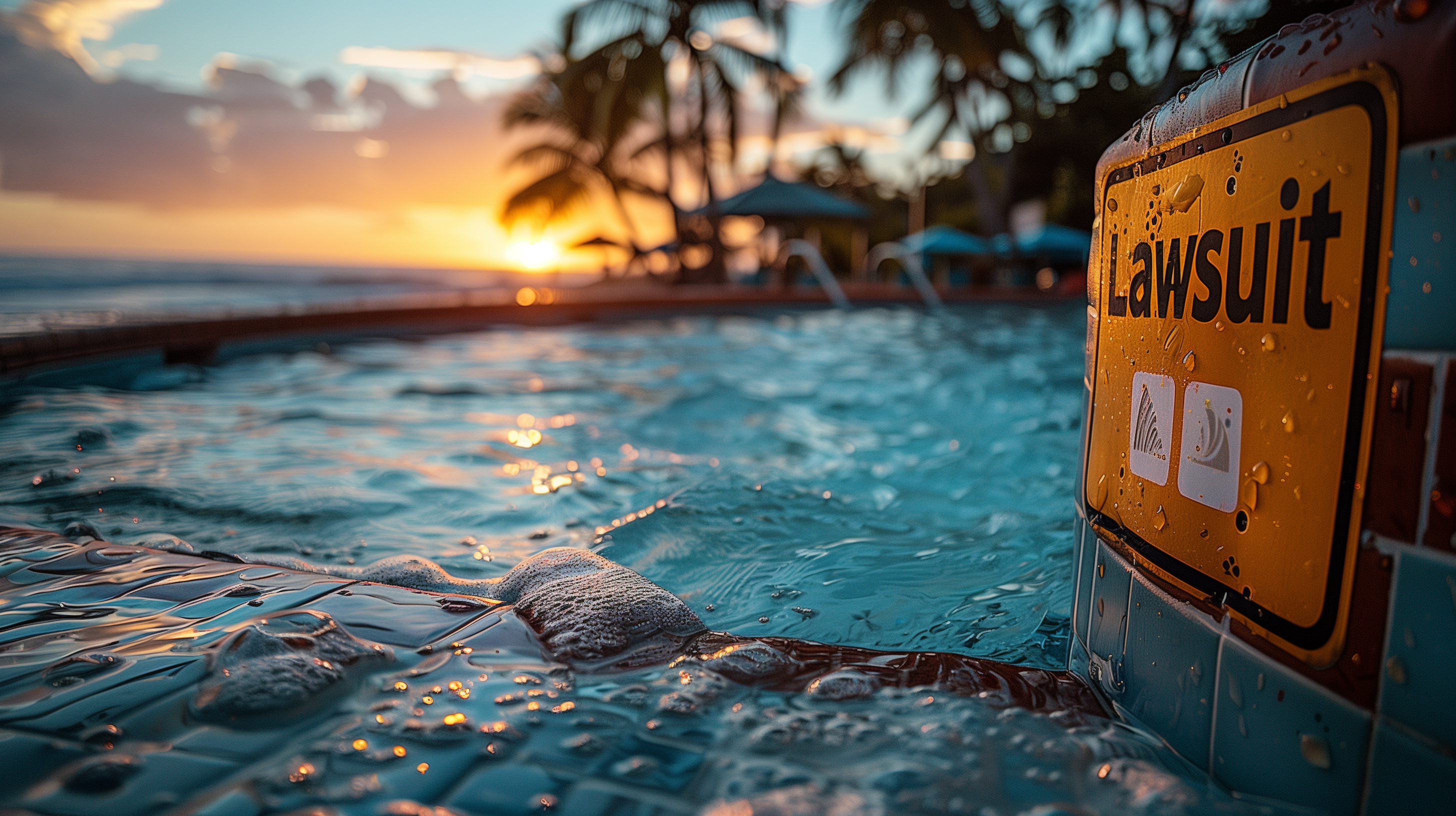
A Texas widow is suing a Mexican resort after her husband died from electrocution in a hot tub. The lawsuit highlights the importance of safety and accountability in the hospitality industry.
by LawInc Staff
June 15, 2024
The tragic electrocution death of Jorge Guillen in a resort hot tub in Mexico has led to a major wrongful death and negligence lawsuit filed by his wife Lizzette Zambrano against multiple corporate defendants. This article provides an in-depth legal analysis of the key facts, claims, and issues in this high-stakes case.
From detailed explanations of the negligence elements and wrongful death damages sought, to the strategic use of a temporary restraining order to preserve evidence and jurisdictional complexities of the foreign venue, learn what it takes to pursue justice and accountability in a case like this.
Whether you’re a legal professional, law student, or just want to understand your rights if you ever face a similar tragedy, this comprehensive guide breaks down everything you need to know about the Zambrano v. Casago, et al. resort accident lawsuit from start to finish.
1. Understand the Key Facts of the Case
-
- Accident Date & Location: On June 11, 2024 at the Sonoran Sea Resort in Puerto Penasco, Mexico.
- Parties Involved: Lizzette Zambrano (individually and on behalf of her husband Jorge Guillen’s estate) as Plaintiff; Casago LLC, Casago International LLC and High Desert Travel Inc. as Defendants.
- What Happened: Jorge Guillen was electrocuted upon entering the resort hot tub and died as a result. Lizzette was also shocked trying to rescue him. Video footage of the aftermath of the incident has been circulated online, reportedly showing the chaotic scene and bystanders attempting to resuscitate Guillen.
- Alleged Negligence: Lawsuit claims defendants failed to maintain the hot tub, warn of the hazard, inspect it, train employees, or implement emergency procedures.
- Damages Sought: Wrongful death and survival action damages individually and on behalf of Jorge’s estate, exceeding $1 million.
- Official Investigation: The General Prosecutor’s Office of Justice of the State of Sonora has initiated an investigation into the incident, seeking to determine the cause of the electrical malfunction and the circumstances surrounding Jorge Guillen’s death.
Case Facts Summary:
-
- The electrocution incident occurred on June 11, 2024 at the Sonoran Sea Resort hot tub in Puerto Penasco, Mexico, which was allegedly operated and maintained by the defendant companies Casago LLC, Casago International LLC, and High Desert Travel Inc.
- Lizzette Zambrano’s husband Jorge Guillen died after being electrocuted upon entering the hot tub, and Lizzette herself was shocked trying to pull him out. The couple was on vacation at the resort with family.
- The lawsuit petition alleges that faulty wiring in the hot tub led to Jorge’s electrocution and death after about 10 minutes in the water before staff could get him out. It claims the defendants did not properly maintain or inspect the hot tub area, post any warning signs, or have emergency shutoff procedures.
- Zambrano seeks damages individually and on behalf of Jorge’s estate for his pre-death pain and suffering, medical and funeral expenses, and her own loss of consortium, in addition to punitive damages. The amount sought exceeds $1 million.
How This Helps Your Case:
-
- Noting the specific date, location and parties involved is critical to establishing the basic factual foundation of your case and properly identifying all potential defendants to name in your suit.
- Detailing what exactly happened to cause the fatal incident, in this case the faulty wiring electrocuting Jorge in the hot tub and Lizzette’s subsequent shock trying to help him, provides key context for your negligence claims.
- Outlining your main theories of negligence, such as failure to maintain, warn, inspect, train, and implement safety measures, demonstrates how each defendant breached its duties and connects their conduct to the damages.
- Summarizing the main categories of damages sought, like wrongful death, survival, loss of consortium, and punitives, shows the full scope of relief needed and the range of harms caused by defendants’ actions.
Legal Considerations:
-
- Identifying All Defendants: Be sure to name every potential entity or individual who may bear some responsibility in the suit, from the resort owners to management companies to maintenance providers, to maximize potential recovery sources.
- Jurisdictional Challenges: While the incident occurred in Mexico, the plaintiff argues that the Texas court has jurisdiction because the defendants have significant ties to the United States. These ties include maintaining offices and conducting business operations in Texas and Arizona. The plaintiff will need to provide evidence of these connections to establish personal jurisdiction over the defendants in a U.S. court. However, the defendants are likely to challenge this, arguing that Mexico is the more appropriate forum for the case, as the incident occurred there and many witnesses and pieces of evidence are located in Mexico.
- Applicable Law: Research Mexican tort and wrongful death laws as well as any international treaties that may come into play, as defendants may argue that Mexican law and damage caps should apply to an incident there vs. Texas law.
- Damages Proof: Gather all medical and funeral bills, any pre-death conscious pain evidence, economist reports on lost earning capacity, and mental anguish testimony from family to substantiate six and seven-figure damage claims.
- Punitive Arguments: Since punitive damages require showing defendants’ actions were willful, wanton or grossly negligent, look for any evidence suggesting they knew the hot tub had issues or was a safety risk but failed to fix it or warn guests.
2. Analyze the Negligence Elements & Liability Theories
-
- Duty: As resort operators and managers, defendants owed guests a duty to maintain safe premises, facilities and attractions free of hazards, as well as to properly train staff on safety measures.
- Breach: The faulty wiring in the hot tub shows defendants failed to maintain it in safe condition, and lack of warnings, inspections, and emergency training/procedures breached their duties.
- Causation: But for the defendants’ negligent acts and omissions, the hot tub would not have been in a dangerously electrified state and Jorge would not have been killed when entering it.
- Damages: Jorge sustained a fatal electrocution as a direct result of defendants’ negligence, leading to medical and funeral costs, Lizzette’s loss of consortium, and his pre-death pain and suffering.
- Respondeat Superior: Since the alleged failures in maintaining the hot tub and training employees were done in the course and scope of defendants’ resort operations, they are vicariously liable for their agents’ misconduct.
Liability Summary:
-
- The lawsuit asserts straightforward negligence claims against the resort owner/operator defendants, arguing that as “possessors” of the property they owed duties of care to maintain safe premises and facilities for their business invitees like Jorge and Lizzette.
- Allowing the hot tub to fall into disrepair with faulty, exposed wiring capable of electrocuting guests is a clear breach of their duties to keep it in reasonably safe condition and to discover and remedy any dangerous conditions in a timely manner.
- Additional breaches include failure to properly inspect the hot tub, post any warning signs advising of the hazard, and implement emergency procedures or train staff on how to promptly shut off the power and perform guest rescues and first aid in such situations.
- These breaches directly caused Jorge’s death by electrocution and Lizzette’s own shock and injuries in trying to help him, as the current would not have been running through the water but for the defendants’ various negligent acts and omissions in how they maintained and operated it.
How This Helps Your Case:
-
- Clearly establishing the key elements of a negligence claim, from the defendants’ legal duties to the breaches of those duties to causation and damages, creates a straightforward path to liability.
- Focusing not just on the obvious failure to maintain the hot tub itself, but also related breaches like lack of inspections, warnings, and emergency procedures, provides multiple avenues to prove negligence.
- Demonstrating how these multiple breaches all combined and contributed to cause the fatal electrocution and related damages preempts defendants’ efforts to minimize their responsibility for the full scope of harm.
- Arguing vicarious liability via respondeat superior ensures the corporate defendants cannot escape accountability by trying to foist off all blame onto individual low-level employees.
Legal Considerations:
-
- “Invitee” Duty: Premises liability duties of care are highest for business invitees like resort guests, so emphasize that elevated duty defendants owed here vs. mere licensees or trespassers.
- Notice of Hazard: If evidence shows the faulty wiring issue existed for some time before the incident, argue defendants had actual or constructive knowledge of it sufficient to trigger a duty to remedy.
- Industry Standards: Research hospitality industry standards and best practices for hot tub and pool maintenance, inspection, and safety to show how defendants’ conduct fell short.
- Employee Training Policies: Request all training materials, handbooks, and written policies to demonstrate the inadequacy of employee training on safety procedures and emergency response.
- Prior Incidents: Investigate whether any other guests were injured or complained about hot tub issues before to prove notice and a pattern of negligence.
3. Understand the Wrongful Death, Survival & Loss of Consortium Claims
-
- Wrongful Death Action: Lizzette brings this claim as a surviving spouse to recover for her own personal losses from Jorge’s death, like loss of financial support, services, care, maintenance, advice, counsel and companionship.
- Survival Action: This is brought by Lizzette on behalf of Jorge’s estate to recover damages he personally suffered from the negligence while still alive, like his pre-death pain, suffering and mental anguish in the moments before he died.
- Loss of Consortium: Lizzette has her own individual claim for loss of consortium to compensate for the loss of love, companionship, comfort, care, assistance, affection, society, and relations she will no longer have with her husband due to his death.
- Exemplary Damages: Also known as punitive damages, Lizzette seeks these to punish the defendants for gross negligence in allowing such an extremely dangerous hazard to exist and cause Jorge’s death.
- Damage Amounts: The petition states Lizzette seeks wrongful death and punitive damages over $1,000,000 for her personal losses, Jorge’s pre-death pain and suffering, and to penalize defendants’ misconduct.
Damages Summary:
-
- The lawsuit seeks a variety of damages under the Texas wrongful death and survival statutes, starting with Lizzette’s personal losses compensable in a spousal wrongful death action like loss of financial support, household services, care, advice and companionship.
- It also pursues survival action damages on behalf of Jorge’s estate, which are the damages he suffered directly from the electrocution while still alive, however briefly, such as his physical pain, suffering and mental anguish in the minutes before he succumbed.
- Lizzette’s individual loss of spousal consortium claim seeks further non-economic damages for the loss of her husband’s love, comfort, companionship, assistance, affection and intimate relations, as a separate category from the wrongful death losses.
- The petition also makes a claim for exemplary/punitive damages due to the alleged gross negligence of the defendants, which requires showing their actions involved an extreme degree of risk and conscious indifference to guests’ safety and welfare.
How This Helps Your Case:
-
- Asserting all available damages categories under the Texas wrongful death and survival statutes ensures you seek the maximum compensation for all losses and harms suffered, both to Lizzette individually and to Jorge’s estate.
- Distinguishing between Lizzette’s personal wrongful death losses like lost financial support and the survival claim for Jorge’s own pre-death pain and suffering illustrates the separate interests and rights at stake.
- Including an individual loss of consortium claim highlights the deeply personal relational and intimate harms Lizzette has uniquely suffered from losing her spouse, above and beyond the other economic wrongful death damages.
- Placing the defendants’ actions in the context of gross negligence and malice justifies a potentially substantial punitive damage award to punish and deter such extreme misconduct by resort owners and operators entrusted with guests’ safety and very lives.
Legal Considerations:
-
- Caps on Damages: Research any applicable Texas or Mexico statutory caps on punitive damages or non-economic losses in wrongful death suits, and be prepared to prove amounts over those caps at trial.
- Calculating Lost Support: Work with economic experts to determine the full value of Jorge’s financial contributions to the family, including his salary, benefits, household services, and expected future earnings increases.
- Proving Consortium Losses: Gather evidence showing the closeness and quality of Jorge and Lizzette’s marriage before his death, such as photos, videos, cards, letters, and testimony from family and friends.
- Conscious Pain & Suffering: Emphasize the 10-minute period Jorge was being electrocuted in the hot tub, to prove he experienced conscious pre-death pain as opposed to instantaneous loss of consciousness.
- Gross Negligence Evidence: Focus discovery on proving defendants’ lack of safety inspections, hot tub maintenance, employee training, and emergency response illustrates not just negligence but a conscious disregard for risks.
4. Employ a Temporary Restraining Order & Injunctive Relief to Preserve Evidence
-
- Evidence at Risk of Destruction: The petition alleges key evidence like the faulty hot tub components, surveillance videos, and employee witness statements are at risk of being destroyed, altered, or lost forever.
- Restraining Order Sought: Lizzette seeks a temporary restraining order to immediately prevent the defendants from altering or destroying the hot tub, video footage, employee logs, and communications related to the incident until a hearing can be held on the matter.
- Temporary & Permanent Injunction Sought: After a hearing, Lizzette requests a temporary injunction to continue preservation of evidence during the suit, and a permanent injunction as ultimate relief.
- Reasons Stated: The application argues the restraining order and injunction are needed because defendants are likely to destroy key evidence in their possession without a court order stopping them.
- Harm to Plaintiff: Plaintiff asserts she will suffer “irreparable harm” without injunctive relief because once defendants destroy the evidence, it can never be recovered and her ability to prove her claims at trial will be lost.
Emergency Relief Summary:
-
- The lawsuit takes the critical step of seeking an immediate temporary restraining order and further injunctive relief to ensure key evidence remains available for inspection and use in proving plaintiff’s claims at trial.
- It identifies the specific pieces of evidence most at risk for alteration or destruction in defendants’ possession, like the hot tub itself, any security camera footage of the incident, and employee records and communications from that day. The plaintiff argues that these items are crucial for proving her claims and that the defendants are likely to alter or destroy them if given notice.
- Plaintiff requests a temporary restraining order (TRO) to preserve the evidence, arguing that the defendants are likely to alter or destroy key evidence if given notice. While the petition does not explicitly request an ex parte TRO (without notifying the defendants), the urgency of the situation and the potential for evidence destruction could lead the court to grant such an order.
- The application also seeks both a temporary injunction to preserve evidence during the pendency of the litigation after a subsequent hearing, and a permanent injunction as part of the final judgment to forever prevent defendants from destroying or disposing of the items.
How This Helps Your Case:
-
- Seeking an emergency TRO and injunctive relief shows the judge how crucial preserving this evidence is and how at risk it is for destruction in defendants’ hands without court intervention.
- Specifying the key items of proof like the hot tub components, video footage, and employee records illustrates exactly what you need preserved and why to build your strongest case.
- Arguing irreparable harm to the case if the evidence is forever lost demonstrates why plaintiff is entitled to this exceptional emergency relief outside the normal procedures, and previews the merits.
- Coupling the initial TRO with follow-up temporary and permanent injunctions ensures the evidence remain protected through trial and any appeals, not just at the start of the case.
Legal Considerations:
-
- Requirements for Ex Parte Relief: Understand and be prepared to prove the strict criteria for TROs, including irreparable harm, no adequate legal remedy, and likelihood of success on the merits – the argument for destruction of evidence can satisfy these if well-pled.
- Full Injunction Burden of Proof: Be ready to present a strong evidentiary showing at the temporary injunction hearing to clearly prove your likelihood of prevailing at trial and irreparable harm.
- Potential Appeal: Defendants may try to immediately appeal the TRO or temporary injunction, so build the strongest certified record and be prepared to defend against any appellate attacks.
- TRCP 167 Authorizations: Consider requests for inspection and production under Rule 167 in tandem with the injunctive relief, to promptly obtain access to the evidence once preserved.
- Spoliation Argument: If defendants destroy evidence despite the order, pursue death penalty sanctions like default judgment, and emphasize the spoliation to the jury as proof of defendants’ guilty mind.
5. Prepare for Complex Jurisdictional & Cross-Border Law Issues
-
- Location of Resort & Accident: The incident occurred at a resort in Puerto Penasco, Mexico, though plaintiff is a Texas resident and defendants have some Texas and Arizona business ties.
- Basis for Personal Jurisdiction Alleged: Lizzette argues specific personal jurisdiction is proper over defendants in Texas because they purposefully availed themselves of doing business in the state and her claims arise from those contacts.
- Anticipating Forum Non Conveniens: Expect defendants to argue Mexico is the more convenient forum since the accident occurred there, and that Mexican law should apply under applicable choice of law rules.
- Researching Mexican Tort Law: Given the strong chance of Mexico’s laws controlling the case, it’s crucial for the plaintiff’s legal team to thoroughly research Mexican tort liability and damages rules. This research should include a detailed comparison of Mexican and Texas law, particularly regarding liability standards, available damages, and any limitations on claims related to resort accidents.
- Hague Evidence Convention: If the case proceeds in Texas but evidence remains in Mexico, utilize the Hague Evidence Convention procedures for international discovery and depositions. The Hague Evidence Convention is an international treaty that provides procedures for obtaining evidence from foreign countries for use in legal proceedings.
Jurisdiction & Conflicts Summary:
-
- The cross-border nature of this case, with the electrocution occurring in Mexico but the plaintiff residing in Texas and suing defendants also present in Texas and Arizona, sets up several complex jurisdiction and choice of law battles that will shape the litigation.
- Plaintiff seeks to keep the suit in Texas by arguing the defendants have minimum contacts with the state via their business activities and targeted marketing to Texas residents for Mexican resort stays, making specific jurisdiction proper.
- However, defendants will almost certainly file a forum non conveniens motion to dismiss the Texas action, arguing Mexico is the more convenient location since all the accident evidence and many witnesses are located there.
- Defendants are also likely to argue that Mexican tort and damages law should apply to an incident occurring in Mexico, rather than Texas law, under applicable conflict of law analyses for the most significant relationship to the case.
How This Impacts Your Case:
-
- Personal jurisdiction and forum non conveniens arguments will likely be a threshold battle, as defendants try to move the case to Mexico and plaintiffs fight to keep it in their chosen Texas forum.
- If the case gets moved to Mexico, plaintiffs may face lower damage caps, stricter liability rules, and other less favorable tort laws than in the U.S., so keeping it in Texas could provide an important advantage.
- Even if Texas retains the case, odds are high Mexican substantive law will still apply under choice of law doctrines for torts, so plaintiff’s counsel must quickly get up to speed on Mexico’s liability and damages standards.
- Gathering evidence and witness testimony from Mexico will pose added costs and challenges, such as compliance with Hague Evidence Convention procedures for foreign discovery and depositions.
- Adding U.S. defendants like maintenance or parts companies who serviced the resort could help establish personal jurisdiction and tilt the forum non conveniens analysis against dismissal.
Legal Actions to Consider:
-
- Extensive Jurisdictional Discovery: Conduct thorough research and discovery into defendants’ business registrations, office locations, marketing activities, and other contacts with Texas to defend against dismissal.
- Mexican Law Experts: Retain bilingual legal experts on Mexican tort law to provide affidavits and testimony establishing proof of foreign law and how it would apply to the case facts.
- Significant Relationship Analysis: Develop choice of law arguments under the “most significant relationship” test, emphasizing factors like defendants’ U.S. presence and plaintiffs’ Texas residency to advocate for applying Texas over Mexican law.
- Hague Discovery Planning: Coordinate with Mexican counsel or foreign discovery services to identify and collect all evidence in Mexico via Hague Convention letters rogatory, depositions, and other internationally-recognized processes.
- Amended Complaint: Consider amending the petition to add any additional U.S. defendants like sister resort management companies, contractors, suppliers, or maintenance firms to bolster personal jurisdiction ties.
Conclusion
The Lizzette Zambrano v. Casago LLC, et al. lawsuit over the electrocution death of Jorge Guillen in a Mexican resort hot tub provides an unfortunate but important case study in complex tort litigation involving negligence, wrongful death, injunctive relief, and cross-border jurisdiction and choice of law issues.
While the core underlying facts allege straightforward negligence by the defendants in failing to properly maintain the hot tub and causing Mr. Guillen’s death, the case also explores more nuanced issues like the categories of damages available in wrongful death and survival actions, the standards for temporary restraining orders and injunctions, and the tests for personal jurisdiction and choice of laws in transnational tort suits.
Ultimately, this case spotlights the steep risks and tradeoffs that can arise when tragedy strikes far from home, but also maps out a path to navigate such perils. By aggressively preserving evidence, carefully selecting defendants, exhaustively documenting damages, and zealously fighting for the best forum and law, plaintiffs’ counsel can still position international resort wrongful death cases for positive outcomes.
This heartbreaking case is also a somber reminder of the ever-present dangers that can arise even in seemingly tranquil vacation settings, and the vital importance of taking all steps to ensure the safety of resort and hospitality facilities.
No amount of legal damages can ever replace a loved one, but hopefully this lawsuit can bring some measure of justice and accountability. And if it spurs other hotels and resorts to reevaluate and elevate their safety practices, it may succeed in sparing others similar grief.
In a world where so many rely on the care and competence of hospitality providers, this case is a critical call to uphold the highest standards of guest wellbeing and prevent such senseless tragedies.
Contact an Experienced Resort Accident Lawyer
If you or a family member has been seriously injured or killed due to negligence at a resort, hotel, or other hospitality venue, contact an experienced premises liability and wrongful death attorney right away to understand your rights and legal options.
Resort and hotel injury and death cases often involve complex issues of negligence, foreseeability, hidden dangers, notice, vicarious liability, jurisdictional conflicts, international law, and challenging damages valuation and proof. Having knowledgeable counsel experienced in these particular matters is critical to securing the maximum compensation possible.
Most reputable resort accident and wrongful death law firms offer free consultations to assess your potential case and advise you of your options. Reach out to a skilled lawyer today to ensure you preserve all available evidence and legal claims before any deadlines expire.
Zambrano v. Casago Lawsuit Quiz
Questions: Case Facts & Tort Liability
-
- 1. Where did the tragic electrocution incident at the center of this case occur?
- A) Texas
- B) California
- C) Arizona
- D) Mexico
- 2. What is the relationship between the decedent, Jorge Guillen, and plaintiff Lizzette Zambrano?
- A) Parent and child
- B) Spouses
- C) Siblings
- D) Friends
- 3. Which of the following defendants is NOT named in the suit?
- A) Casago LLC
- B) Casago International LLC
- C) High Desert Travel Inc.
- D) Sonoran Sea Resort Inc.
- 4. What was the specific mechanism of injury alleged in the complaint?
- A) Electrocution from faulty hot tub wiring
- B) Drowning in the resort pool
- C) Slip and fall on wet pavement
- D) Food poisoning from resort restaurant
- 5. What is the main tort cause of action asserted against defendants?
- A) Negligence
- B) Strict products liability
- C) Breach of warranty
- D) Assault and battery
- 1. Where did the tragic electrocution incident at the center of this case occur?
Answers: Case Facts & Tort Liability
-
- 1. D) The electrocution occurred in a hot tub at the Sonoran Sea Resort in Puerto Penasco, Mexico.
- 2. B) Lizzette Zambrano is the surviving spouse of decedent Jorge Guillen.
- 3. D) Sonoran Sea Resort Inc. is not named as a defendant; instead the named defendants are Casago LLC, Casago International LLC and High Desert Travel Inc.
- 4. A) Jorge Guillen was electrocuted due to alleged faulty wiring in the resort hot tub.
- 5. A) The main claim is negligence against defendants for failure to maintain the hot tub, warn, inspect, and implement safety measures.
Questions: Damages & Procedure
-
- 1. Which of the following damages are NOT sought in the petition?
- A) Wrongful death
- B) Survival statute
- C) Loss of consortium
- D) Intentional infliction of emotional distress
- 2. How much in monetary relief does plaintiff seek?
- A) Over $200,000
- B) Over $500,000
- C) Over $1,000,000
- D) Unspecified
- 3. What legal tool does the plaintiff use to request the court to prevent the defendants from altering or destroying evidence?
- A) Temporary restraining order and injunction
- B) Expedited discovery order
- C) Appointment of special master
- D) None
- 4. What is the main argument for granting the requested temporary restraining order?
- A) Defendants are likely to destroy key evidence without it
- B) Plaintiff cannot afford to post a bond
- C) The hot tub is an attractive nuisance
- D) Defendants have no insurance
- 5. Which of the following is NOT a likely defense challenge to the Texas court’s jurisdiction?
- A) Lack of minimum contacts
- B) Forum non conveniens
- C) Improper venue
- D) Unclean hands
- 1. Which of the following damages are NOT sought in the petition?
Answers: Damages & Procedure
-
- 1. D) The petition does not specifically assert a claim for intentional infliction of emotional distress, but does seek wrongful death, survival, and loss of consortium damages.
- 2. C) Plaintiff alleges damages over $1,000,000 in the petition.
- 3. A) Plaintiff seeks an immediate temporary restraining order and injunction to prevent defendants from altering, destroying or operating the hot tub, or losing key video and employee evidence.
- 4. A) The main argument for the TRO is that defendants are likely to destroy critical evidence in their possession without an emergency court order stopping them.
- 5. D) Unclean hands (a doctrine that prevents a plaintiff who has acted unfairly from obtaining relief) is an affirmative defense to the merits, but not a jurisdictional challenge, while lack of minimum contacts with Texas, forum non conveniens (Mexico more appropriate), and improper venue are all likely jurisdictional attacks defendants may raise.
Disclaimer
The information in this article discussing the Zambrano v. Casago LLC et al. lawsuit is based solely on the allegations and claims made in Plaintiff’s Original Petition. No independent investigation of the facts has been conducted.
The legal analysis represents the opinions of the author based on the limited information available in the initial pleading. No prediction or guarantee of the outcome of this case is made herein.
This article is for general informational and educational purposes only and does not constitute legal advice or form an attorney-client relationship. If you require legal guidance, please consult with a licensed attorney in your jurisdiction.
Related Articles











